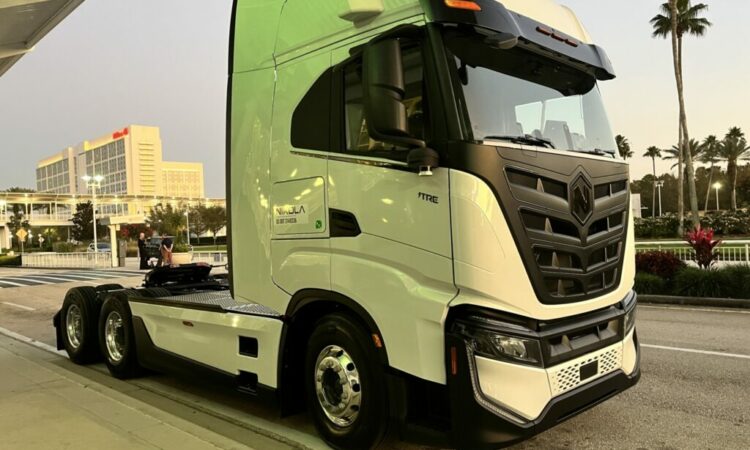Nikola’s Tre battery-electric tractor seems to attract a crowd everywhere it goes. The truck has been exhibited at several trade shows, always surrounded by throngs of curious gawkers. Some of that curiosity stems, no doubt, from the novelty of the cab-over-engine configuration. The last new COE we had to fawn over here in North America was Freightliner’s Argosy, which appeared in 1998.
At the time, market share for COE trucks had declined to about 3%. Freightliner was predicting a revival of the configuration because it was technically capable of hauling a trailer up to 58 feet long. Fifty-eight-footers never caught on. Nor did the Argosy. It was withdrawn from the North American market in 2006, but remained in production for South Africa, Australia, and New Zealand until 2020 – also remaining available in North America as a glider kit until that time.
Nikola was offering ride-n-drives on a battery-electric Tre at the American Trucking Associations’ Technology & Maintenance Council annual meeting. Slots to get a ride were booked within hours of posting the invitations. Media types were offered extended drives later in the afternoon, after the potential paying customers had a go at it.
Nikola Tre BEV is a cabover for a new era: Test Drive

by Jim ParkApril 5, 2023
Nikola’s Tre battery-electric tractor seems to attract a crowd everywhere it goes. The truck has been exhibited at several trade shows, always surrounded by throngs of curious gawkers. Some of that curiosity stems, no doubt, from the novelty of the cab-over-engine configuration. The last new COE we had to fawn over here in North America was Freightliner’s Argosy, which appeared in 1998.
At the time, market share for COE trucks had declined to about 3%. Freightliner was predicting a revival of the configuration because it was technically capable of hauling a trailer up to 58 feet long. Fifty-eight-footers never caught on. Nor did the Argosy. It was withdrawn from the North American market in 2006, but remained in production for South Africa, Australia, and New Zealand until 2020 – also remaining available in North America as a glider kit until that time.
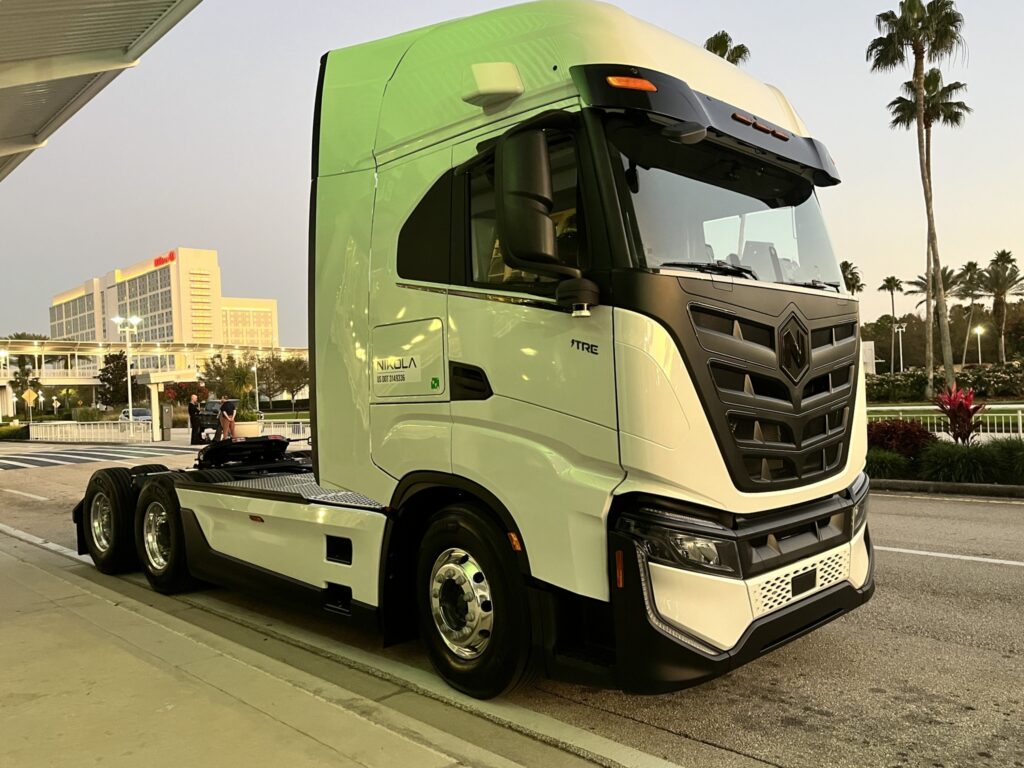
Nikola was offering ride-n-drives on a battery-electric Tre at the American Trucking Associations’ Technology & Maintenance Council annual meeting. Slots to get a ride were booked within hours of posting the invitations. Media types were offered extended drives later in the afternoon, after the potential paying customers had a go at it.
I had about an hour behind the wheel, when I took a lap around the convention center and then headed out onto the freeway.
The first thing you’re struck with in the Tre is how high you sit. The cab floor is nearly five feet off the ground and the driving position is a foot or so higher than most conventional trucks. The big windshield and the sheer drop to the ground right out front gives the impression of altitude. The view is amazing.
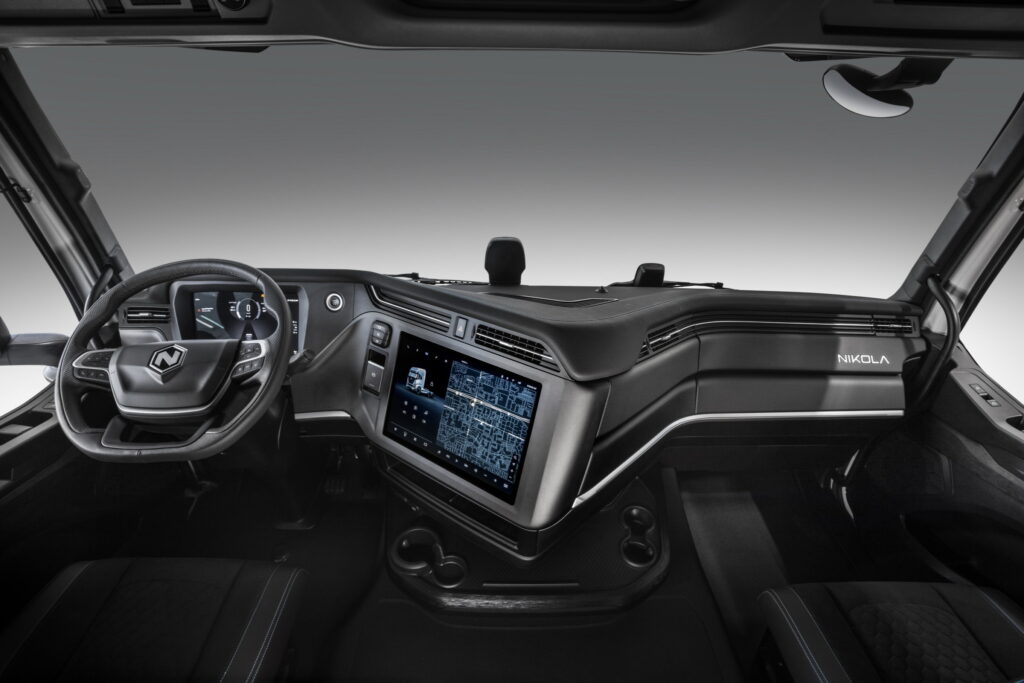
The digital cockpit
The wraparound dash sits fairly tall, leaving no misunderstanding that you’re in a truck. The dash panels are very tidy, too. There are few mechanical controls, save for the parking brake release switches. I say switches rather than valves because that’s what they are. Nikola uses the Bendix Intellipark system. It’s an electronic switch wired over the actual brake valves, which are probably tucked under the cab somewhere. You can’t hear the parking brakes release or apply, which is a bit strange.
All the information the driver really needs is on the dash A-panel — the speedometer and the battery state-of-charge indicator. When the truck is moving, the screen displays lane position, following distance, which is tied into a stock ADAS (advanced driver assistance system). It’s very uncluttered and easy to read, with white lettering on a black background.
While other OEMs have recently introduced glass display dash panels, none are as large as the 17-inch B-panel touchscreen in the Tre. This is where drivers can choose a multitude of functions from the menus. The common stuff, like headlights, climate control, and radio, are always displayed, with other items laying not too deep in the various menus. There’s even a touch-control on the screen for the diff locks and other mechanical functions. It’s all electronically controlled now.
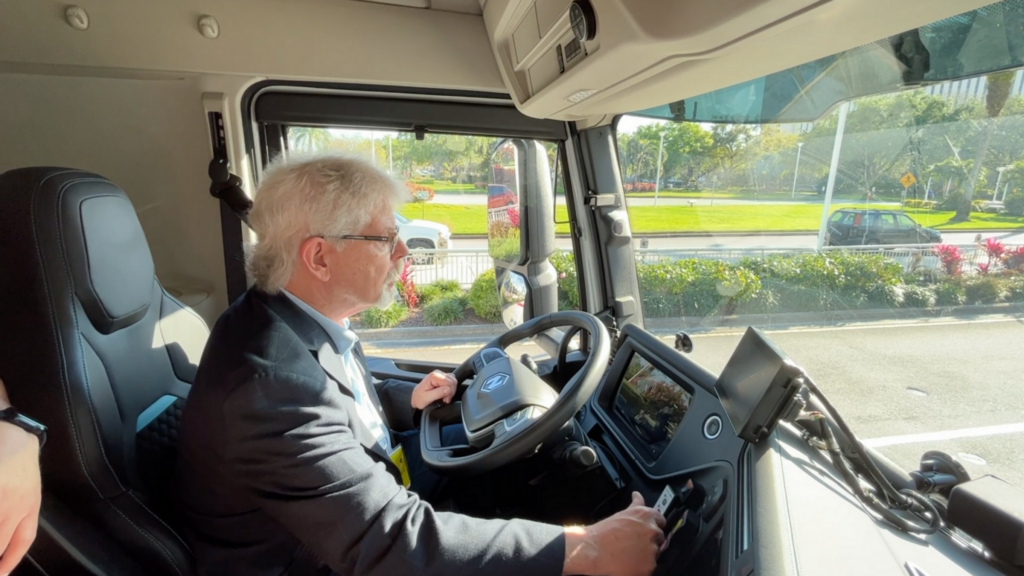
Nikola Tre cab and chassis
The Tre stands just over 13-feet tall and sits on a 186-inch wheelbase — a standard length for a day cab tractor. It looks longer because there’s so much open space behind the cab. Sitting between the steer tires and the drive wheels are nine modular battery packs with 733 kWh capacity.
The cab sits on four dampened air springs, carefully tuned for stability, stiffness and comfort. The front axle is a three-leaf taper spring. The rear suspension is an innovative eight-bag air-ride affair. All wheel positions feature air disc brakes.
Under the cab sits all the electronics and electrical hardware, convertors, invertors, and coolers. It’s a really tight packaging job, but engineers had a flat-floor cab to work with rather than the engine-tunnel designs of yesteryear. (Drivers called that tunnel the doghouse. It was a great place to lay for a nap, but it made getting into the sleeper a real pain.)
Space and quiet
The cab is actually a standard European single-bunk sleeper setup. It wouldn’t be tolerated by drivers here, used to 60-plus inches of off-duty space. In Nikola’s demo trucks, the space at the rear of the cab is a bench seat, which will still qualify as a sleeper for Hours of Service compliance. Nikola says a full sleeper cab will be available on the longhaul fuel-cell version of the Tre.
There’s almost seven feet of space between the floor and the ceiling. You can stand up and walk around in the thing.
The seats are huge and extraordinarily comfortable, and generally the look and feel of the interior is pure premium. There’s a header panel above the driver with a few storage spots and the ubiquitous coffee cup holders below the dash with a bit more storage there.
It’s extraordinarily quiet inside, thanks to the absence of a diesel engine. Tire and geartrain noise is non-existent, but there was some wind noise, and the air conditioning fans and even the electrical system cooling fans were audible. Those fans (smaller than traditional diesel cooling fans) emitted a low hum, not the howl we associate with cooling fans on diesels.
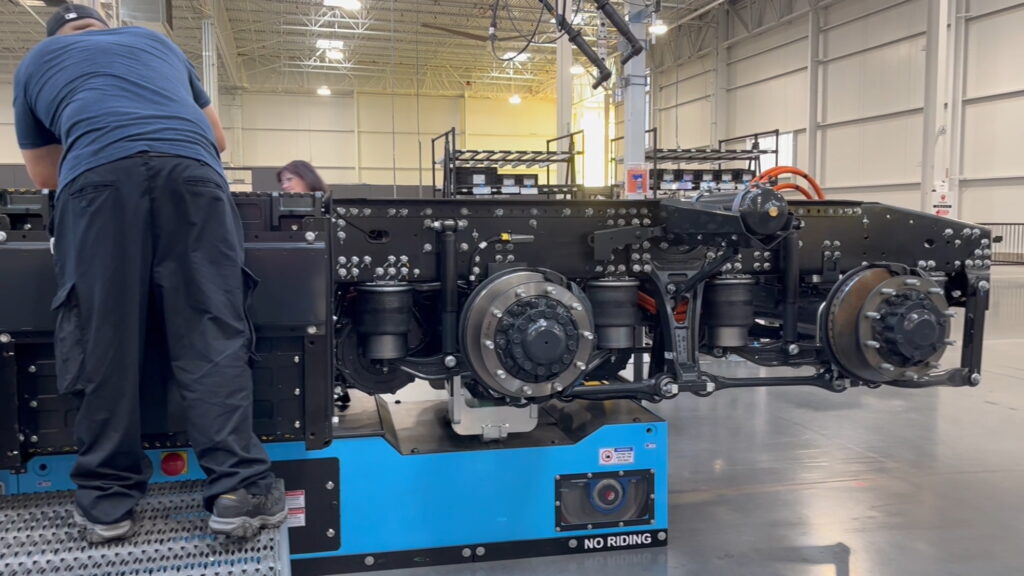
Close-quarters maneuvers
In my opinion, the beauty of the Tre lies in its maneuvering capabilities. Its steering and throttle pedal response are just fantastic. (Can we still call it a throttle pedal?)
This will make some people crazy, but the accelerator pedal in the Tre responds like the old mechanical 3406 Caterpillar diesels for throttle response. There was nothing finer, in my opinion. I’ve been told Nikola’s engineers spent a great deal of time on the pedal mapping for the Tre. The power rolls on very smoothly and it’s very responsive, of course. It’s electric. If you’re smooth on the pedal, it will treat you — and your tires — nicely.
Just the slightest pressure on the pedal got the truck moving, but it only went as a fast as I pushed the pedal down. Articulate would be a good word to describe the pedal feel. Just like those old Cats.
“The Tre’s steering, while electric and no doubt also relying on sensors and motors for centering, has a more familiar mechanical feel to it.”
Since the seating position is just ahead of the steer axle hub, you’re actually out in front of the wheels, leading the turn rather than following — a bit like a bus. And it has a pretty dramatic steering cut, turning on a dime. Drivers will be pleasantly surprised at how tight it turns and how surefooted it feels in a corner. There’s no cab sway despite its height.
While I wouldn’t call myself an expert on steering feel in electric trucks, I’ve driven a couple I wasn’t really happy with. Those trucks didn’t seem to have the “feel” of a hydraulic system. All vehicles rely to a certain extent on positive caster to help with the centering effect. Some electric systems seem to rely more on sensors and motors to return the wheels to center after a turn. It just doesn’t feel the same.
The Tre’s steering, while electric and no doubt also relying on sensors and motors for centering, has a more familiar mechanical feel to it. That’s one way of saying the engineers got that part right. And that’s important since drivers, especially local and regional drivers, spend a lot of time steering their trucks.
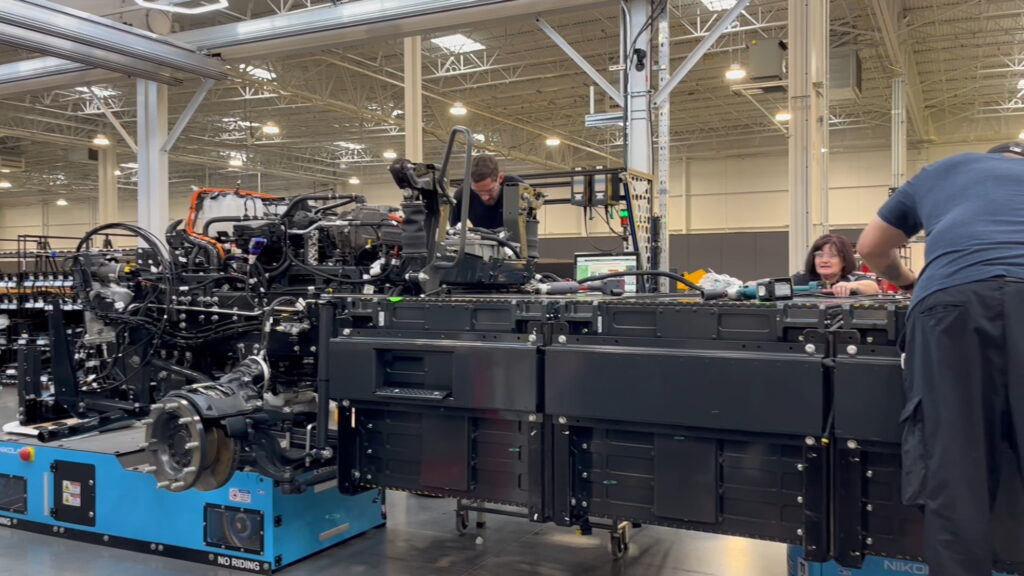
Tre’s BEV performance
My Tre drive in Orlando lasted less than an hour, and with maybe 15 minutes in the freeway, bobtail, I can’t honestly say anything meaningful about its performance. I also had an opportunity to drive a Tre at Nikola’s headquarters in Coolidge, Ariz., last summer. That, too, was a brief drive, but I did have a loaded trailer (82,000-lb. GVW), and had it up to highway speed for about 30 minutes.
During that drive, one of the engineers told me a stock Tre can maintain 55 mph (just under 90 km/h) on a 5-6% grade. The Tre’s two drive motors can deliver up to 645 hp to the wheels. The torque numbers aren’t published, but they would be well north of 2,000 lb-ft at any rpm.
The other side to all that get-up-and-go is the Tre’s notable retarding power. During testing on the 11-mile (18-km), 5% grade at Davis Dam near Bullhead City, Ariz., the test-Tre managed the entire descent, fully loaded at 82,000 lb., using only regen braking.
It has a six-position regen braking control on the steering column, like most of today’s AMT shifter stalks. With a bit of practice, a diligent driver can motor around town hardly ever using the service brakes except to hold the truck stopped. I would say that skill will become the modern equivalent of the smooth-shifting diesel jockey we once revered.
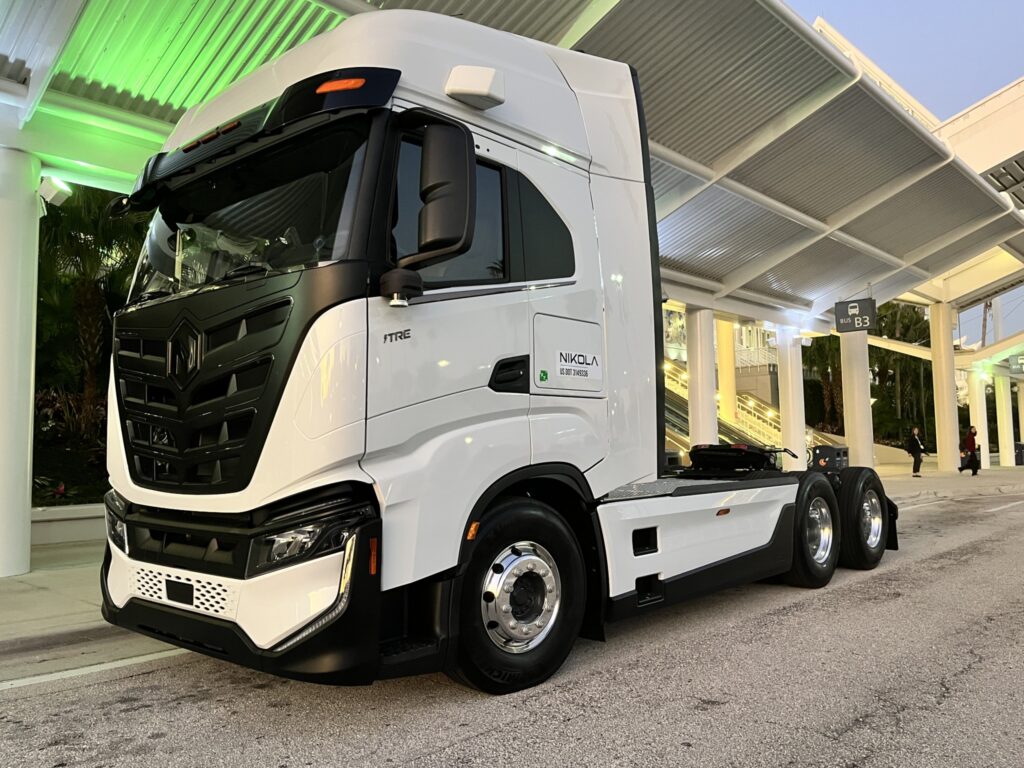
Nikola Tre final thoughts
The 800-lb gorilla here is the weight of the Tre. Nikola hasn’t published a number yet, but a fleet owner who has already purchased several of the trucks told me it weighs close to 29,000 lb. (13,150 kg). Nikola has confirmed that number.
The “typical” weight for a BEV day cab with about 350-400 kWh batteries is about 22,000 lb., but at 733 kWh, Tre has about twice the battery capacity. Nikola has told me it may offer a smaller pack in the future, but for now everything is shipping with the full battery complement.
Evaluating electric drivetrains is new territory for me. I understand diesel torque curves and gear ratios and how to predict performance and drivability. I’m still learning about electric systems. I could offer an intelligent side-to-side comparison of say, a Cummins versus a Mack engine, but I’d be hard-pressed to describe in significant detail the difference between a Nikola Tre and a Freightliner eCascadia — at least beyond the obvious.
It seems at this early stage to be every bit as good as its competitors, but time will tell if the Tre can live up to the million-mile benchmark established by legacy OEMs.


